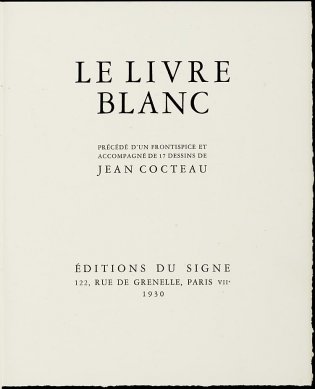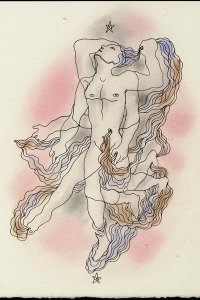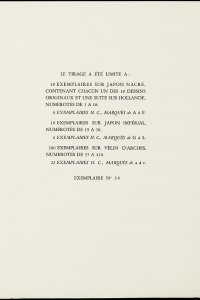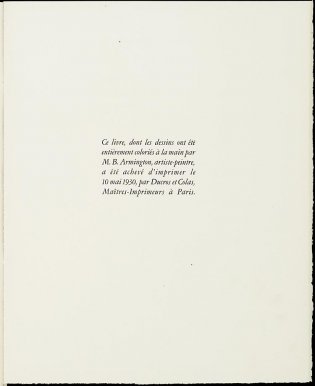Le livre blanc
Year: 1930
Author: Jean Cocteau (1889 - 1963)
Artist: Jean Cocteau (1889 - 1963)
Publisher: Éditions du Signe
The first edition of Le livre blanc appeared in 1928, under the copyright of Maurice Sachs and Jacques Bonjean in Paris. Pascal Pia, the author of a bibliography of the erotic collection of the Bibliothèque nationale de France, wrote that the editors received the book without its creator’s name or address. But Pia recognized the names of Sachs and Bonjean in the initials on the title page, making this an official publication of Les Quatre Chemins, which had already published another book by Cocteau that same year: Le mystère laïc. (Cocteau had a hard time with Sachs; Sachs had for instance sold Cocteau's library.) Both gentlemen also played dumb by claiming not to know the author, while the colophon informs us that 10 copies had been reserved for the author, while the total edition consisted of only 31 copies! Pia's suspicions were justified, and after publication, neither Sachs nor Cocteau were very discrete about their involvement. The second edition followed in 1930 under a faked imprint: Editions du Signe, printed on 10 May 1930 by Ducros and Colas in Paris in an edition of 450 copies. The drawings were hand-coloured by M.B. Armington.
Cocteau wrote Le livre blanc in 1927 in Chablis, where he was staying with Jean Desbordes, the successor to Cocteau's great love. Cocteau's drawings have been described as obscenely pious. They are established by quick, flowing lines, partially erotic and often sultry, featuring classical elements such as busts and centaurs. Erotic images were popular articles in France, where they were sold under the counter; people were extra careful about homosexual erotica. Cocteau described his first sexual experiences in Le livre blanc: his excitement upon seeing a naked peasant boy on horseback and two naked young gypsies on his father's estate. He also wrote about his father, in whom he recognized a homosexual inclination. Some scenes in Le livre blanc refer to Cocteau's love for Desbordes, others to the adventures of Maurice Sachs. Neither man was to survive World War II: Desbordes was tortured to death by the Gestapo, while Maurice Sachs played an enigmatic double role during the war, and subsequently disappeared.


![Pagina [71] met facsimile van Jean Cocteau's handschrift](/sites/default/files/styles/galerie/public/images/le-livre-blanc-p71.jpg?h=8dfb6f16&itok=x9cOIMBu)
![Pagina [75]: illustratie door Jean Cocteau](/sites/default/files/styles/galerie/public/images/le-livre-blanc-p75.jpg?h=fba49d59&itok=dhDkkjeU)
![Pagina [85]: illustratie door Jean Cocteau](/sites/default/files/styles/galerie/public/images/le-livre-blanc-p85.jpg?h=2a43dbe3&itok=oR1MmPzH)
![Pagina [99]: iillustratie door Jean Cocteau](/sites/default/files/styles/galerie/public/images/le-livre-blanc-p99.jpg?h=7a269184&itok=BBZNCo2C)

